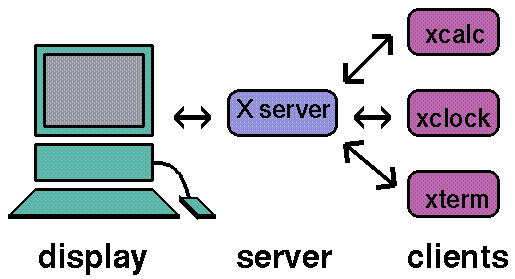![[EdCert previous]](../../edcert/images/prev.gif)
![[EdCert next]](../../edcert/images/next.gif)
![[EdCert top]](../../edcert/images/top.gif)
"In all other client/server relationships, the server is the remote machine that runs the applications (i.e. the server provides services, such as a database service or computation service). For some perverse reason that's better left to the imagination, X insists on calling the program running on the remote machine "the client." This program displays its windows on the "window server." We're going to follow X terminology when discussing graphical client/servers. So when you see "client" think "the remote machine where the application is running" and when you see "server" think "the local machine that displays output and accepts user input."
(The UNIX-HATERS Handbook)

A display usually consists of a terminal screen, keyboard and mouse. Frequently the display and the workstation are the same. This is not always the case as a display can have multiple screens. A display is controlled by a special program known as an X server. There is only one X server per display. Clients are user programs such as text editors, clocks and calculators. A client receives all of its input and output through requests to the X server. The server handles all of the input and output to the display. It creates windows, produces text and graphics on the screen, etc. Clients cannot access the display directly, they must go through the server.